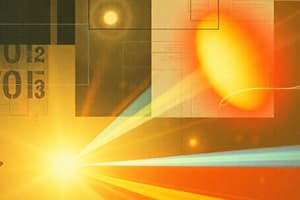Podcast
Questions and Answers
¿Cuál es la principal característica que hace que el oro sea adecuado para aplicaciones de espectroscopía?
¿Cuál es la principal característica que hace que el oro sea adecuado para aplicaciones de espectroscopía?
- Su alta reflectividad en el espectro visible
- Su capacidad para difractar la luz
- Su habilidad para refractar la luz
- Su capacidad para absorber altas energías fotónicas (correct)
¿Cuál es la principal aplicación de las láminas de grafito?
¿Cuál es la principal aplicación de las láminas de grafito?
- Absorber toda la luz que incide sobre ellas
- Refractar la luz a diferentes ángulos
- Difractar la luz a través de aperturas estrechas
- Reflectar selectivamente longitudes de onda específicas de la luz (correct)
¿Cuál de los siguientes materiales NO se considera un material refractivo?
¿Cuál de los siguientes materiales NO se considera un material refractivo?
- Agua
- Lentes
- Vidrio
- Oro (correct)
¿Qué fenómeno ocurre cuando la luz viaja a través de aperturas estrechas o alrededor de pequeños objetos?
¿Qué fenómeno ocurre cuando la luz viaja a través de aperturas estrechas o alrededor de pequeños objetos?
¿Cuál de las siguientes propiedades de la luz NO se ve afectada por la refracción?
¿Cuál de las siguientes propiedades de la luz NO se ve afectada por la refracción?
¿Qué fenómeno se refiere al rebote de ondas (o partículas) desde una superficie hacia otro medio?
¿Qué fenómeno se refiere al rebote de ondas (o partículas) desde una superficie hacia otro medio?
¿Cuál es el material utilizado para reflejar altas frecuencias de luz, como radiación UV o IR, y tiene una excelente reflectividad para la luz visible?
¿Cuál es el material utilizado para reflejar altas frecuencias de luz, como radiación UV o IR, y tiene una excelente reflectividad para la luz visible?
¿Cuál es la ley que establece que el ángulo de incidencia es igual al ángulo de reflexión?
¿Cuál es la ley que establece que el ángulo de incidencia es igual al ángulo de reflexión?
¿Qué material es altamente reflectante en todo el espectro visible y se usa comúnmente para recubrir espejos de telescopio para mejorar su reflectividad?
¿Qué material es altamente reflectante en todo el espectro visible y se usa comúnmente para recubrir espejos de telescopio para mejorar su reflectividad?
¿Cuál es uno de los materiales usados para la reflexión que es ideal para espejos y paneles solares debido a su reflectividad para la luz visible?
¿Cuál es uno de los materiales usados para la reflexión que es ideal para espejos y paneles solares debido a su reflectividad para la luz visible?
Flashcards are hidden until you start studying
Study Notes
Light
Light is an electromagnetic wave consisting of alternating electric and magnetic fields moving through space. It has both particle properties, exhibiting energy quantization behavior, and wave properties, showing interference and diffraction patterns. Here's an overview of light properties, its interaction with materials, and some related phenomena:
Reflection
Reflection refers to the bouncing of waves (or particles) back from a surface into another medium. When light hits a reflective surface at a certain angle, it may either be absorbed or reflected depending on the surface material and the angle of incidence. The angle of reflection can be determined using the law of reflection, which states that the angle of incidence is equal to the angle of reflection.
Types of Materials for Reflection
Materials used for reflection are usually transparent or reflective, such as mirrors made of aluminum, silver, gold, or other metals, polished metal surfaces, glass, water, and even graphite foil. These materials have specific purposes based on their reflectivity, transparency, and absorbance characteristics. For example:
- Aluminum: Used for reflecting high frequencies of light, such as UV or IR radiation, and has excellent reflectivity for visible light, making it ideal for use in mirrors and solar panels.
- Silver: Highly reflective across the entire visible spectrum, making it commonly used for coating telescope mirrors to enhance their reflectivity.
- Gold: Reflects both visible light and high energy photons, which makes it suitable for applications like spectroscopy where different types of light are needed.
- Graphite foils: Used for selectively reflecting specific wavelengths of light, such as in optical filters for solar cells.
Refraction
Refraction describes how light changes direction when traveling from one medium to another, usually passing through an interface. This phenomenon can lead to a change in speed, angle, color (dispersion), and even polarization.
Types of Materials for Refraction
Materials that refract light have properties that allow them to bend light waves while absorbing some of the energy. Some examples include glass, water, lenses, and other transparent materials with varying refractive indices:
- Glass: Commonly used for lens production due to its ability to refract light based on its composition and structure.
- Water: A highly refractive material, causing light to slow down and bend as it passes through this medium.
Diffraction
Diffraction occurs when light (or any wave) travels through narrow slits or around small objects. It's characterized by interference patterns resulting from constructive and destructive superposition of light waves. These patterns form due to the phase difference between the light waves that pass through different paths or around obstacles.
In summary, light interacts with materials in various ways depending on the properties of these materials. Different substances exhibit unique characteristics in reflection, refraction, and diffraction, leading to diverse applications across industries such as optics, astronomy, telecommunications, and more. Understanding these phenomena is crucial for developing technologies aimed at manipulating and utilizing light effectively.
Studying That Suits You
Use AI to generate personalized quizzes and flashcards to suit your learning preferences.




